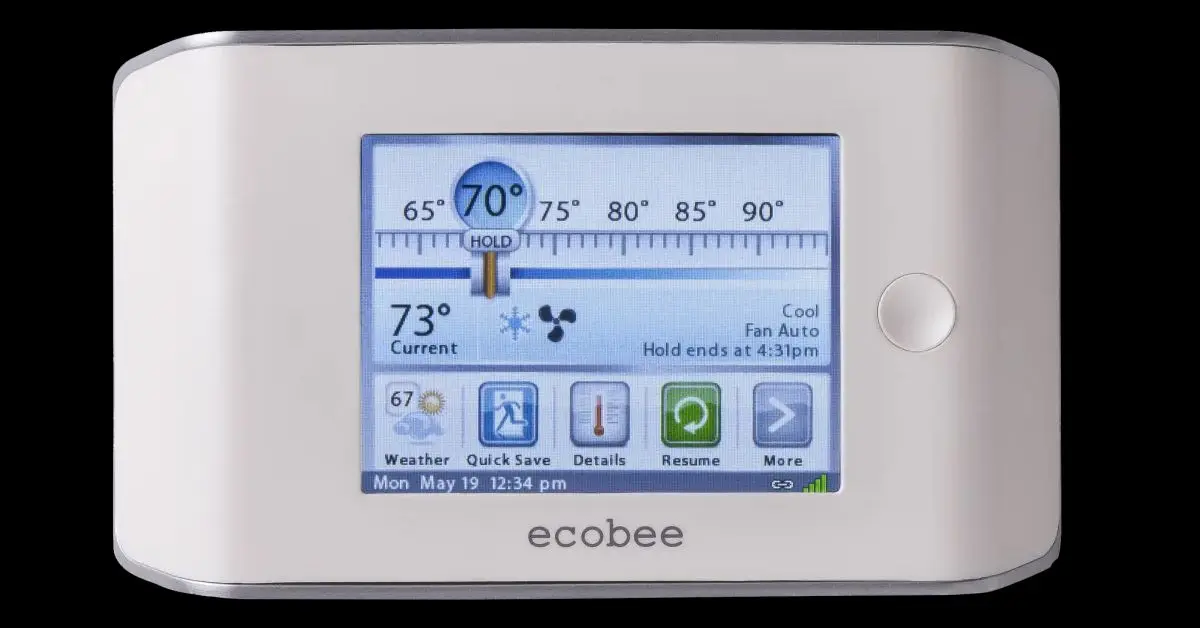Our smart thermostat has never been all that useful to me. The main thing is I don’t have to walk over to it to change the temp. But that convenience isn’t really worth the $150 I paid for it.
deleted by creator
I get the idea and it’s kinda cool, but not +$100 cool when I can just turn it down/off before I leave.
deleted by creator
using it as I described really saves money
Assuming I:
- own a heat pump ❌
- own solar panels ❌
- own a smart water heater of some kind? ❌
- live somewhere that the temp changes enough that any of this matters ❌
“No you idiot, you just have to spends thousands of dollars on equipment and then you can save $100 a year”
Do you realize how ridiculous you sound? Good for you that you’re saving money, but I’m just giving a personal anecdote here, not writing a thesis on home energy management.
You don’t need solar panels. Could also just be dynamic energy pricing. Also do not need a water heater. Thermal mass could just be heating the place at a certain time. Don’t get the bit about temp changes, maybe you mean you never heat or cool your place?
This is why I’m all in for non-“smart crap”, I don’t even have inductive heating stove top because they never have basic knobs.
Long clicking on [3] then + + + + + + to boil your f eggs? No thanks.
deleted by creator
Wow so cheap too 😅
It’s just on and then hold b for boost now. It automatically detects which slot you have placed your pan on and selects that for you. But I get your point…
Induction is great 👍
That is a horrible argument.
Just get a non shit induction stove
I just bought one of these! First press on, then wait a second for the pan to be detected, then select the burner to turn on, then + which sets it to 5/10, then press + 5 more times for full power! The one with knobs was like double price…but hey the pan heats up quick while you are cursing at it.
If it detects the pan, why do you need to tell it which burner to use?
It will light up an indicator for each pan detected, so if 2 pans are on the stove you still need to activate the one you want. Assuming you don’t want both on.
I just bought one of these!
There weren’t any better options?
Did you try e.g. long pressing buttons, pressing -, or anything?
I had the +/- buttons ages ago (cheap alternative when renting). Never again.
Long clicking on [3] then + + + + + + to boil your f eggs?
A lot of them have a terrible UI. But that’s far from all of them. Enough have sliders. Sometimes one with a pan detection. Sometimes a slider per area.
I got the Frigidaire professional 36” induction and it does have knobs 😎
deleted by creator
Probably because they do still have a local API, will maintain wifi support, and can still be used with HomeAssistant or whatever other local home automation server you have.
Furnaces last 20-30 years…
Zero excuse. Hell I know people with a 30 year old tstat.
It’s a switch, on/off on temp. Everything else is fancy crap that they can shut off forcing you to buy again.
The switch part will still work. How are you not getting this?
Cause I didn’t bother to read it and I assumed standard business practice.
I don’t understand the mindset of people who buy these things in the first place. Occasionally there’s an article like, “guy’s entire house suddenly inoperable after Amazon ban,” people just don’t think that will happen to them? It is local control on a standardized protocol or nothing for me.
Today yes, not 16 years ago.
The newer Ecobee’s can run entirely locally through their homekit integration. I tie mine into home assistant and use it that way. I would never have bought the device if that wasn’t available.
If this old version doesn’t have that available then I’m assuming people purchased it knowing that it was reliant on cloud services. It would be nice if they offered customers options besides just letting the device turn into e-waste but you can understand why they don’t want to burn development hours on a device that’s a decade and a half old.
Just another reason to never buy devices that can’t function without a cloud service.
Yeah. The server and software should be open source and API available. That way we actually own the system and don’t have to just toss it out if someone goes out of business.
Fucking ulock for example suddenly wants me to create an account and sign in to their website to use my front door lock! What the fuck is that! We need consumer protections for this sort of shit. I didn’t sign up to giving away when I come in and when I go out of my house! WTF to the max!
As per the Ecobee notice this only impacts the two original models and they still function as regular thermostats still, they are just not providing any of the smart / cloud features anymore.
Newer units support local homekit control, which can also be paired with open systems like Home Assistant for full local control for automation.
That’s why one uses an industry standard that is brand-independent,operates offline by design and does not require a central component besides a power supply.
Sounds like utopia?
This standard has been available since 1990 in its archaic form, since 2002 in its current form. It is downwards compatible and over 400 companies worldwide are part of the standard. HomeAssistant, ioBroker, openHAB,etc. all support it directly and there are multiple crossover gateways with other standards like DMX, ModBus, Dali,etc. exist. And no, it’s components are not more expensive once you look at the TCO.
For fucks sake, people, use KNX.
2002 is pretty archaic in technological terms.
So is windows and Linux if you just look at the year they were introduced.
Just because something is backwards compatible doesn’t mean it does not get updates/improved.
And tbh, a light switch does not need that much improvement technology wise.
Fair enough. I didn’t read it as being currently maintained in your original post.
The thing is: The standard itself is rather well designed and didn’t need too much updates (they just extended the possible packet contents in terms of possible parameters - which technically isn’t that necessary as you can fall back to ASCI).
The last major updates were more towards extending functions (KNX over RF), connecting locations via IP tunnel, and securing the packets themselves (which is not really necessary for single household installations but VERY much for multi tennant installations).
The major strength of KNX is the bus packet system itself - as the packets are standardized there are only a few attack avenues. An attacker could flood the bus with packets, try to update with fraudulent code (if none did put a password on it) or try to put fraudulent content in a module that accepts ASCI packets. The problem is the access - the attacker would need physical access or the IP gateway (if existing)would need to be unsecured towards the internet… In the end it is a fairly resilient piece of software.
And to add another unpopular opinion:
A smart temperature control is the one I never ever need to use. Because then the room always has the temperature I want.
If you have a home office or someone is at home 24/7, then yes. Otherwise it would make sense to reduce the heating/cooling of the house when no one is home and setting the correct temp again when people are about to get back. Saves quite a few bucks.
The system does exactly that - But that is done automatically without intervention.
The system recognises by checking on our devices and the presence detectors if we are at home. If we aren’t it reduces the temperature.* Then it looks into our calendars when we can be expected to be back and increases the temperature accordingly (additionally once we enter a certain Geofence).
*:The overall heating effort is also based on the current and expected weather and sun-influx,as I have some rooms that basically heat themselves when the sun is out. The system is using that effort to adjust shades (e.g. it would allow a lower living room temperature in the morning after we left when it knows that there will likely be a sunny afternoon heating the room without the need to add external heat)
This is what I mean with smart: A smart system is only smart if the user doesn’t have to fiddle around with it. Everything else is a remote.
(My next goal is to add personalised heating. I want the system to recognise who is/comes home and adjust the temperature accordingly as my wife wants other temperatures as I do. O can do it room based, e.g. the kid’s room is adjusted according to the kid being there, but overall I am not quite there yet)
Ok, how do I use it?
Get a few components (e.g. Actors, a sensor), a gateway (USB is enough for the start,they often go cheap if you buy used,got mine for 10 bucks) ,a power supply (Meanwell is a good idea) and the free version of the ETS programming tool. (The ETS is the only downside of the system - it’s expensive especially for larger installs)
I’m sorry, but that’s not very helpful. It also doesn’t sound nearly as easy as an off-the-shelf smart thermostat.
Also https://www2.knx.org is down so I don’t trust it as a stable long term solution.
No,it isn’t. But no open and local solution will be - but you pay for that in terms of long term usability, resilience and data. It’s a choice a mature customer needs to make. Be cloud and manufacturer reliant,invest the time to do it properly or pay someone to do it.
And KNX.org works for me(even tried it with a VPN to be sure) - and do you really think that a standard that is supported by the largest companies in the field(Siemens, ABB, Bosch, Schneider, etc.) and has multi-billion of installations in professional buildings alone per year is not for the long term?
For fucks sake, people, use KNX.
I thought you’d say OpenTherm!
Haha, no. But I know someone who was part of the OpenTherm development.
To quote him:
OpenTherm exists because Plumbers don’t trust Sparkys and Sparkys don’t trust plumbers.
OpenTherm is easy to install but “stupid” as hell and not adaptable to modern needs mostly, especially if you consider modern heating concepts like passively heated houses, heat pumps,etc.
That’s different from KNX (or Modbus in that regard) - They are much broader in their appeal. Singule use/walled garden systems are always a bad idea,imho.
OpenTherm is easy to install but “stupid” as hell
Ah, good but not nice to know. OpenTherm is really popular in the Netherlands. Not nice because I know loads who have such a thermostat. Oh well.
A link to the official notice: https://support.ecobee.com/s/articles/Connectivity-and-Support-for-Legacy-Products
(It was the first link in the article, good job The Verge)
Thermostats are easy to change out. So this isn’t a huge deal. But I don’t love the idea that tech isn’t built to be self-hosted or maintained in any meaningful way. If you’re not shipping an open source version of your software when you close up, you’re an asshole.
Yeah, self hosting isn’t for most lay people if it’s just a GitHub repo. But GitHub repos quickly become adopted by nerds like me who build tooling around it that eventually let lay people self host software with the click of a button.
Newer versions are Homekit compatible and can be controlled over the local network.
As long as HomeKit remains a thing.
Home assistant can talk to homekit devices without involving Apple, so you can assume it’ll be around for a while.
Yeah, 100%. Home assistant can basically connect to any damn thing. Home assistant is going to be the fall back for a lot of legacy iot devices and platforms.
Not quite everything. The stuff that calls home to their own servers can’t be saved by home assistant. If you take care to buy stuff that can be controlled locally, you’re more likely to have some longevity out of your devices.
It is a standard. I don’t know how you can make it not be a thing once it is implemented.
But it’s not an open standard, and all of the 3rd party home kit apps are basically a new client for services that Apple develops.
I say this as someone who sticks with HomeKit because I think it’s one of the better IOT solutions if you care about for privacy and security. My home is all HomeKit compatible. Lutron, Eve, and homebridge for odds and ends.
But I’m fully aware that, if Apple decided to pull the plug, I’d probably be running some sort of local home brewed HomeKit clone on a raspberry pi to keep the network alive.
HomeAssistant is HomeKit compatible and could probably do everything you’ve got going now locally
This is pretty much what happened with HomeAssistant. Tying all the integrations together in one platform.
It’s now at the stage of “copy these files to a pi/buy this box we make”
The overall aim is to integrate most open things, and find ways to work with/around more closed off products.
Yeah, self hosting isn’t for most lay people if it’s just a GitHub repo…
If ecobee put their backend code on GitHub, I bet it would be self hostable with docker within a week.
Are you aware of a decent number of mainstream products that didn’t go full asshole? I agree with you absolutely, but I feel like the majority of connected products pull this same shit.
Yeah the majority do it and I think it’s bad.
It is also nice that these just degrade to regular thermostats. It isn’t like they are completely stopping working. It would be nice if you could swap out the API, or they keep the API running longer (how much work can maintaining it be?). But this sounds like a pretty graceful degradation.
It would be nice to have these speak some common Zigbee protocol or similar. But this isn’t the worst behaviour I have seen from companies.
The company is offering affected users a 30 percent discount on a new Ecobee thermostat, valid for up to 15 thermostats.
…
While I very strongly agree with your message, I have to say that this is one of the least fitting usernames I’ve ever seen.
deleted by creator
16 years old? That thermostat has sure had a run, must have been designed pretty well to last this long without some electronic failure.
Assuming it’s cloud connected, anyone aware whether it got updates for the newer versions of TLS and root certificates? As an example I’m aware quite a lot of android and similar devices from that era have expired certificates now, and outdated/vulnerable SSL libraries…
Edit: Edit example
For a thermostat that’s built into a house, 16 years doesn’t seem long enough, tbh. A ‘dumb’ thermostat can easily be in use for 30+ years before anyone would even consider replacing it.
But yeah, as you said, if it’s connected to the internet you have to worry about software patches, certificates, etc.
Yeah, the old dumb ones in my house have been there for 50 years.
Yeah the thermostat that was in my home until ~2010 was added in the 20s lol. 16 years isn’t long at all.
16 years old? That thermostat has sure had a run
I have game consoles that are more than twice that old and still play reliably. Apple really skewed our idea of lifespans for electronics, didn’t they? It’s a thermostat, they should be designed to install and forget for the next half-century. It’s a core part of a house, like the plumbing and breaker box.
Didn’t the pace of change influence our perception more than anything else?
Don’t old computers on old operating systems work as well as they did when support was dropped? Much like your example of consoles?
The rate of software gobbling up newly available resources seems to a big reason people feel the need to move on. But I think that is starting to flatten out as the pace of processor improvements slows.
The bloat on the web is a huge burden on older devices too. Especially for your average person.
The bloat on the web and in native software (and in non-native software that is just another copy of Chrome posing as native software) comes from our newly available resources allowing for “lazy” development practices that prioritize cross platform development and other factors over writing efficient native software for each platform.
There are a lot of factors involved in the rate of device turnover. I don’t think any one factor is consistently forcing people to upgrade hardware. It’s a collective situation.
I use my desktop computers, for work, for nearly 10 years past their introduction date before replacing them. (Three more to go for my current machine). For my gaming computer, I swap a major part every 5-6 years.
And to reiterate, I think this rate of change is slowing down. At least for raw processing power and how long it is relevant. The rate of change over the course of personal computing has been massive. And it’s just starting to slow down.
Ah yes. Apple, the company with the longest support windows for secure patches of any phone/tablet manufacturer, are definitely the ones skewing our ideas on the lifespan of electronics.
Why is it so common for Apple users to replace their devices every 1-2 years then? Theres a reason it’s a meme. Regardless of what Apple does with old hardware, they promote this mentality of always needing the next new shiny thing. They’re the pioneers of that.
I’m still on a rooted Samsung from 2017. I know several people who went through 3 iPhones in that time.
16 years? That’s like 8 separate Google project lifetimes.
They just killed my nest cameras, but the thermostat is still supported. I was planning on replacing it with an ecobee this year just because API access is kind of a pain but this is giving me some second thoughts.
Killed, as in the thing you paid for is basically worthless now?
That’s not just planned obsolescence, it’s forced obsolescence
deleted by creator
Why do we allow this? Companies that contribute to operate should be severely penalized if they don’t A)) continue to support legacy products B)) offer FULL replacement if servers/apps shutdown or C)) open source EVERYTHING is they are going to try to kill a device.
I will never understand the appeal for cloud based home automation.
All the spying aside, 16 years and your thermostat is no longer supported sounds ok until you think about how if you replace everything with cloud based equivalents you are always going to be having to replace things going out of service. I think its funny that you pay more for a device that lasts for lot less (How many thermostats have people seen fail?). I guess the companies are happy?
The appeal is remote and centralized management, easier programming and more features. If that’s not worth it to you to replace your thermostat every 16 years, then nobody is forcing you to get one.
But being able to change the temp from my phone from anywhere is worth it to me, as well as including it with other automations for all my connected devices. The appeal is honestly not hard to see, even if it’s not worth it for you personally.
You know (I hope) that that functionality does not require a cloud based service right? You are describing features for things I was playing around with 20 years ago, what you need is a program or app, not a live service. The appeal of controlling your things from your phone is not new.
No it doesn’t require it but it can make it easier. Especially for people that don’t have a robust and centralized way of controlling their smart devices, or only have 1-2 of them. I think the appeal is still obvious.
Honestly this makes me feel that not adopting IOT is still a good idea. Yep I am probably leaving some efficiency on the table, but I get more reliability in exchange.
Every one of my IT colleagues over about 35 is an absolute luddite. No IoT, no smart appliances, and a hardened firewall for everything that needs access. Location tracking and biometrics disabled on our phones, no cloud services, etc.
Shocker…it’s not.
I was told I needed to sell ecobee and nest when I worked in HVAC. I refused because of this and sold everyone white Rodgers because they can’t/won’t just shut down the thermostat screwing the end user. I saw this bullshit from day one.
IOT can work without any cloud service. I have some things automated at home and everything works locally. To control it remotely I use a VPN.
Yeah I know that is a thing I might even be able to figure it out, but I am a bit of Luddite. By choice though, I have an okay understanding of tech but I don’t see the advantage in many cases. I much prefer the reliability and simplicity of legacy tech. Also I am much more likely to be able to fix it myself if needed.
Before sears took a shit, I had to fix my mom’s range. It was built some time in the 90s. The manual has a trouble shooting guide. I was able to call the sears help line and buy just the part I need and get it mailed to me. Everything was designed to be fixed and there was legacy company support.
Even with an IOT LAN. Repair of the hardware and often the firmware is not possible. You just have to buy a whole new expensive smart thing. I don’t like that.
There are options. Some IOT things are even DIY with open specifications and open firmware, so you can build and repair them yourself. And a lot of times it’s the cheapest option, way way way cheaper than the usual IOT stuff, as most electronics used for IOT are dirt cheap.
That’s ok if you ask me, considering that they will still continue to function as regular thermostats
I disagree - definitely not OK by me, though likely legal. People bought this because they wanted and paid extra for an internet connected device, and a regular thermostat is not that. I mean, would you be OK if your TV manufacturer disabled the screen and streamed radio stations instead?
I didn’t say it was ideal, but it’s ok. And it’s definitely better when compared to other companies. Sure, in an ideal world they would have published the source code for their server ensuring that anyone could run their own instance at home. But we don’t live in an ideal world.
The last TV that would’ve lasted 16 years was probably made 40 years ago
I bought my Bravia in 2005 and I’ve still yet to have any issues.
Is this an SD CRT?
1080p LCD.
I bought my first HDTV in like 2011 because the prices were absurd and I didn’t want to waste perfectly fine TV’s I already had. You must have paid $3200 to get that first of its kind TV. Definitely seems like you got lucky for it to last so long
If my TV was 16 years old, and the manufacturer cut off the internet function to it, id be ok with that.
These thermostats still work as thermostats, just without the smart features. Comparing that to turning a TV to a radio is disingenuous. 16 years is a long time, and there are security protocols amongst other things that go obsolete over time and can’t be updated at a certain point on legacy devices.
I honestly can’t understand why anyone would be OK with it. I think our society has been getting trained to just accept whatever they throw at us. “Buying” something no longer means fully owning it, and I’m not OK with that, I just have to live with it.
i say something like this often in real life, but despite it being plainly observable in daily life other people still don’t agree.
it’s on all scales too, or at least it feels like it. moving everything to streaming, always online, etc. want to play a competitive video game with your friends? give a corporation root-level access to your home computer. ads everywhere some greedy ass in a suit can think to stick them whether you pay or not, yet everyone complies like this is normal and i get singled out for caring about our rights as consumers.
i love capitalism i love money
If you bought one of these because you have a heat pump and want to consider the outside temp, that service is now cut off. Not ideal.
AA much hate this might be getting, they’re offering discounts on a new product, and 16 years is a hell of a lifetime. Imagine having to support software written in c99 maybe even c89, with some homebrew UI full of bugs.
and 16 years is a hell of a lifetime
Think about it like this: Even if the average home nowadays had only about 10 such devices (I am quite sure the average home has a lot more), that are needed for kitchen appliances, heating, warm water, window shutters, solar panels, etc to function - that means on average about once a year one of the essential functions in the house stops working unless you replace a part. Not because it’s broken, but because “SW support is discontinued”. Seriously, I want to smash everyones faces for those “early adopters” who think smart homes are great, and of course the companies who put software in every little component.
I’m in my house right now with a perfectly working thermostat that’s 70 years old.
And given the mechanism of action it will continue working in another 70 years.
16 years for hardware used inside of homes is a ridiculously, absurdly, short lifetime. Even for a vehicle that would be pushing the edge of “too short”.
That said 16-year-old software is not that old. If it’s built using sane language choices it should actually be functioning and modern today.
The article says that offline functions will continue to work. So they’ll just become regular thermostats.
That is true, but my smart TV and smart scale both got something like 5 years of updates. Who buys a new scale every 5 years? My parents still have a scale from the 90s that works fine.
Wtf is a smart scale?
It’s a thermostat.
I’m coming from a field where supporting software written in the 70s is the norm.
Your argument is horribly short-sighted and wasteful.
Only 16 years old is extremely recent software that ought to be easily maintained in any sane world.
I understand you may be from a field where supporting software from the 70s is required, however someone is probably paying big bucks for that software as well. Replacing the software you work on might cost millions, replacing a thermostat costs 300 usd.
I would love to live in a world where software support lasts 70 years. But consumers don’t look at software support, so it’s not budgeted in the price, and thus doesn’t happen in the consumer space. Getting 16 years in a consumer device is long.
In the field you’re working, stability, longevity, and robustenes is probably a requirement, not a nice to have.





















